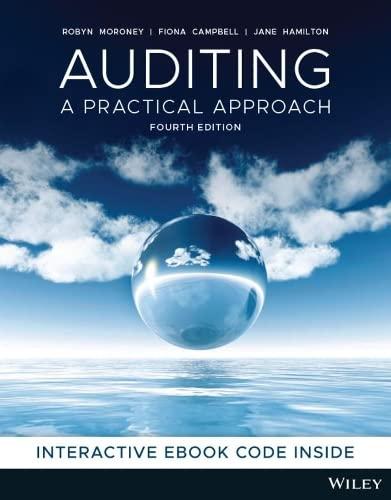At the next planning meeting for the audit, Felix is very happy with the list of risks
Question:
At the next planning meeting for the audit, Felix is very happy with the list of risks you’ve brainstormed as a team. Tia explains that the next task is to narrow down the potential errors or misstatements to a specific account and assertion. She says, ‘This will help us plan the most effective and efficient audit. If we know a specific assertion of an account is at risk, we can spend more time investigating that particular assertion, and less on the others, rather than equal time on each. Audit is all about focusing on where the risks are — we don’t want to do more work than we need!’.
USING THE WORK OF AN EXPERT
Felix reminds the team that AuditTek will also be providing assurance over Crest Outfitters’ climate emissions certification. The climate emissions certification desired by Crest Outfitters is from Climate Neutral and he directs the team to the organisation’s website, www.climateneutral.org, for more information.
To help facilitate this part of the audit, Felix introduces Ziva Huang to the team. She’s a specialist in climate emissions assurance and has come from a specialist environmental consulting practice.
Felix says, ‘Providing assurance over climate emissions and carbon neutrality isn’t so different to a financial statement audit. Instead of the Australian Auditing Standards we have international assurance standards under ISAE 3410 Assurance Engagements on Greenhouse Gas Statements. Instead of reporting according to the Australia Accounting Standards or International Financial Reporting Standards, the client is reporting using the Climate Neutral reporting standards. We still need to collect evidence to provide an opinion about whether Crest’s climate emissions report is free from material misstatement. I’ll be leading this part of the engagement, but I’ll also have Rory and Leigh help me collect the evidence we’ll require and document the work.’
EVIDENCE GATHERING PROCEDURES
Leigh is excited for the next stage of the audit: gathering evidence and testing whether the accounts meet the assertions. She wants to jump right in, but Rory stops her.
‘We need to have a plan,’ he says. ‘We can’t just review the first evidence we come across. We need to finalise the list of risks that we believe will require special emphasis and attention during the audit. These risks are called the significant risks.’
Required
(a) Tia has asked you to prepare the following table based on your output from previous exercises — refer to your brainstorming and assessment, and your analytical procedures from earlier chapters. A risk may affect multiple accounts (remember that there are two sides to every transaction) and multiple assertions; alternatively, some risks may be broader (such as going concern).
(b) Now that you’ve identified the significant risks for Crest Outfitters, you’ve been asked to document and explain your assessment of the overall inherent risk for the client. Remember that risk assessments are conducted on a scale of low, medium or high.
Step by Step Answer:

Auditing A Practical Approach
ISBN: 9780730382645
4th Edition
Authors: Robyn Moroney, Fiona Campbell, Jane Hamilton





